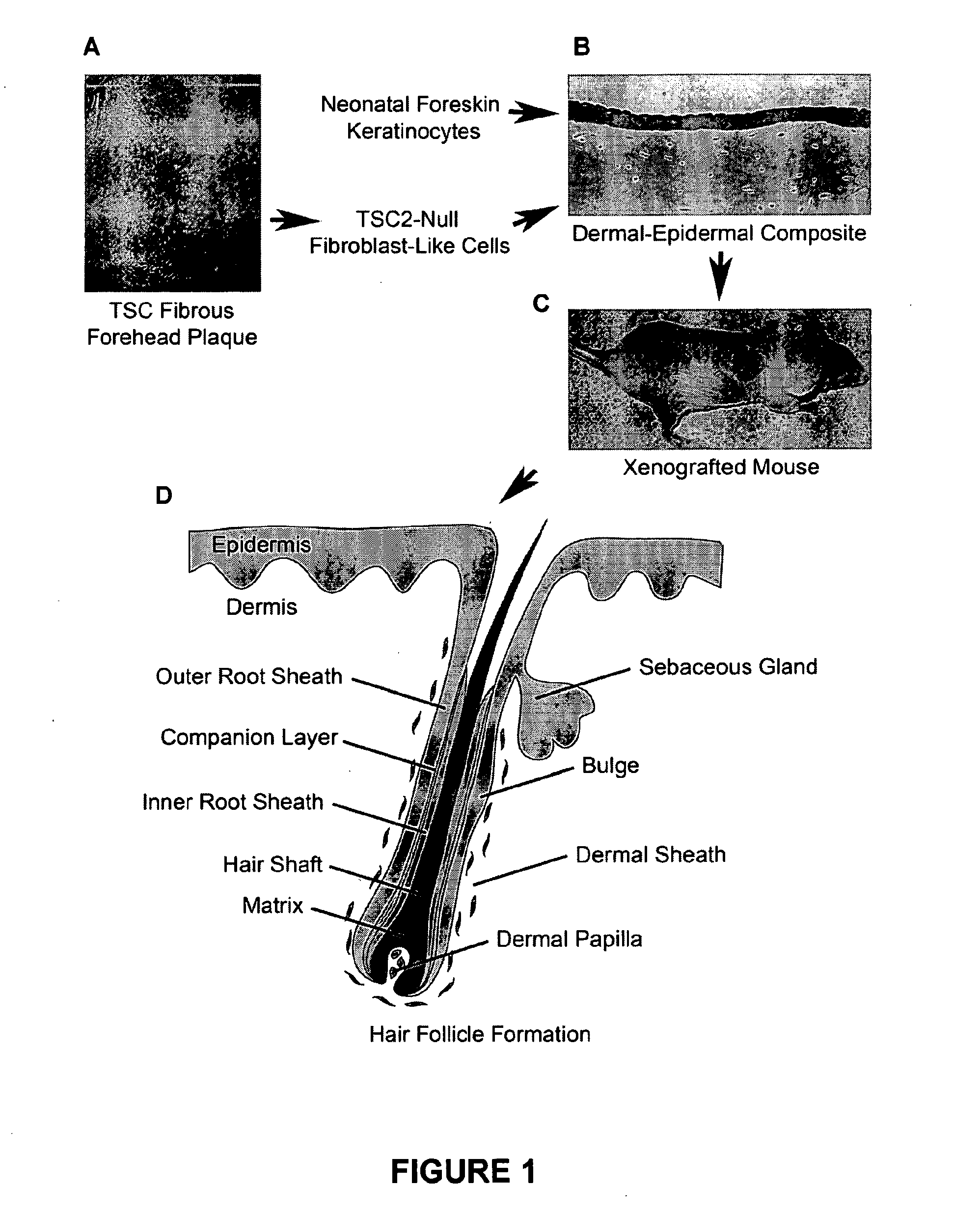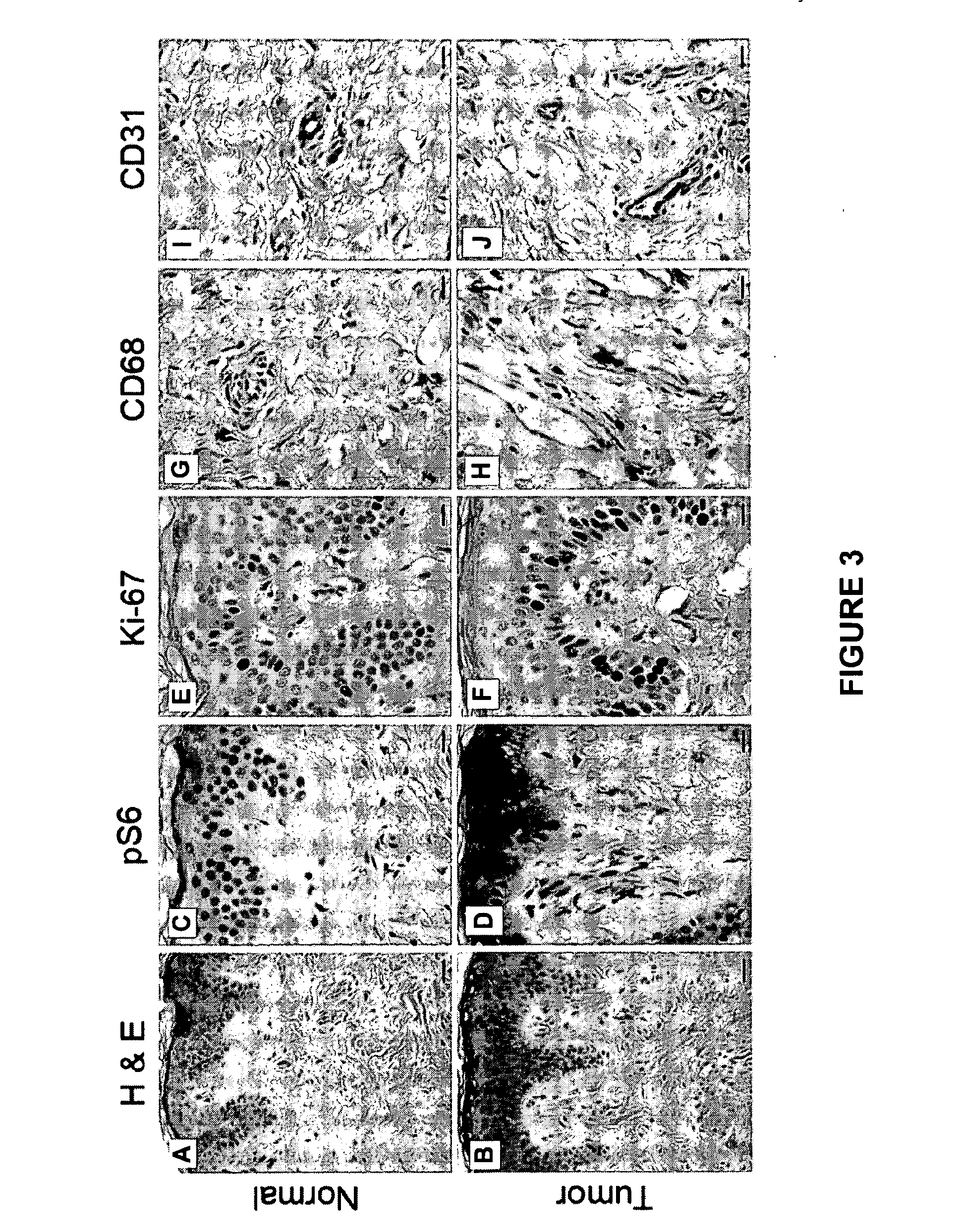Hair follicle neogenesis
- Summary
- Abstract
- Description
- Claims
- Application Information
AI Technical Summary
Benefits of technology
Problems solved by technology
Method used
Image
Examples
example 1
Preparation and Evaluation of Skin Substitute from TSC Patients
[0175]TSC skin hamartomas, including fibrous forehead plaques, angiofibromas, and periungual fibromas, contain dermal and / or perifollicular fibroblast-like cells and variable changes in the epithelium. Patients diagnosed with TSC were enrolled in an Institutional Review Board-approved protocol, 00-H-0051 at the National Heart, Lung, and Blood Institute, NIH. Samples of angiofibromas, periungual fibromas, fibrous plaques, and normal-appearing skin from TSC patients were obtained and bisected, with one portion used for routine pathology and the other used for frozen sections or cell culture.
[0176]A. Histological and Immunohistochemical Comparison of Normal Tissue Samples and Tumor Tissue Samples
[0177]The histological (FIGS. 3A and 3B) and immunohistochemical differences between normal and tumorous patient samples were characterized as a baseline for comparison. Briefly, paraffin sections of the samples were deparaffinized ...
example 2
TSC2 and FLCN Knockdown Studies
[0210]To mimic the loss of TSC2 expression observed in cells with proven trichogenic capabilities, shRNA was used to knock down TSC2 expression in cultured fibroblasts and dermal papilla cells. In addition, since patients with Birt-Hogg Dube syndrome have a loss of FLCN function that leads to the formation of skin hamartomas similar to TSC skin hamartomas, shRNA was also used to knock down FLCN expression in cultured fibroblasts and dermal papilla cells. As discussed below, TSC2 and FLCN knockdowns enhanced the trichogenic properties of cells.
[0211]A. Gene Knockdowns
[0212]Wild-type mesenchymal cells (i.e., dermal fibroblasts and dermal papilla cells) were modified to decrease TSC1 / TSC2 function and increase mTORC1 function by knocking down expression of TSC2 using shRNA to TSC2. In addition, wild-type mesenchymal cells were modified to mimic loss of TSC1 / TSC2 function by decreasing expression of FLCN using shRNA to FLCN. Commercially available lentivir...
example 3
Isolation of Mesenchymal Cells from Adnexal Tumors or Normal Human Skin
[0230]Mesenchymal cells may be isolated from one or more of the following sources: patient skin or mucosa for autologous cells; donor skin or mucosa for allogeneic cells; normal skin or mucosa; skin with an adnexal tumor; and other tissues (e.g. fat, bone marrow, etc.). Fibroblasts may be isolated by enzyme digestion if the sample size is sufficiently large (i.e., greater than or equal to 1 cm3).
[0231]A. Cell Migration Method
[0232]Cells may be isolated from skin samples or skin tumors using a cell migration method. To isolate mesenchymal cells by cell migration from explants, skin samples are cut into small pieces and transferred into 35 or 100 mm sterile dishes containing 1 or 5 mL of 10% FBS / DMEM or mesenchymal stem cell growth medium (MSCGM; Lonza Group Ltd, Switzerland). The plates are incubated in a 5% CO2 incubator at 37° C. The medium is changed twice a week until a substantial number of mesenchymal cells ...
PUM
| Property | Measurement | Unit |
|---|---|---|
| Time | aaaaa | aaaaa |
| Time | aaaaa | aaaaa |
| Time | aaaaa | aaaaa |
Abstract
Description
Claims
Application Information
 Login to View More
Login to View More - R&D
- Intellectual Property
- Life Sciences
- Materials
- Tech Scout
- Unparalleled Data Quality
- Higher Quality Content
- 60% Fewer Hallucinations
Browse by: Latest US Patents, China's latest patents, Technical Efficacy Thesaurus, Application Domain, Technology Topic, Popular Technical Reports.
© 2025 PatSnap. All rights reserved.Legal|Privacy policy|Modern Slavery Act Transparency Statement|Sitemap|About US| Contact US: help@patsnap.com



